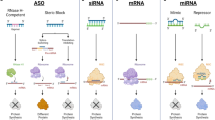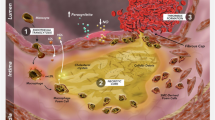Abstract
Lectin-like oxidized-low-density lipoprotein receptor-1 (LOX-1) is increasingly linked to atherosclerotic plaque formation and the soluble form of this receptor may reflect activities of disease. We investigated the associations among levels of sLOX-1, oxidized-low-density lipoprotein (ox-LDL), cytokines and the extension of atherosclerosis in patients with coronary artery disease (CAD). Lipid, TNF-α, IL-6, C reactive protein (CRP), ox-LDL, peroxy radical and sLOX-1 levels were measured in 29 controls and 60 patients with CAD, 30 of which with one or two vessels involved (group 1), and 30 patients with three or four vessels involved (group 2). The serum levels of sLOX-1 were significantly and progressively higher in group 1 [611 (346–1,313) pg/ml, median (interquartile range)] and in group 2 [2,143 (824–3,201) pg/ml] than in control subjects [268 (111–767) pg/ml]. LOX-1 levels positively correlated with IL-6 (r = 0.38, P = 0.0042), TNF-α (r = 0.38, P = 0.0037), CRP levels (r = 0.32, P = 0.027) and age (r = 0.25, P = 0.048). In the multivariate analysis TNF-α resulted the only independent determinant of LOX-1 serum levels (β-value = 0.304, P = 0.017). These findings suggest that sLOX-1 levels are up-regulated during CAD progression and are associated with inflammatory markers. The measurement of the circulating soluble form of this receptor may be potentially useful in predicting CAD progression in humans.

Similar content being viewed by others
References
Sawamura T, Kume N, Aoyama T, Moriwaki H, Hoshikawa H, Aiba Y, Tanaka T, Miwa S, Katsura Y, Kita T, Masaki T (1997) An endothelial receptor for oxidized low-density lipoprotein. Nature 386:73–77
Yoshida H, Kondratenko N, Green S, Steinberg D, Quehenberger O (1998) Identification of the lectin-like receptor for oxidized low-density lipoprotein in human macrophages and its potential role as a scavenger receptor. Biochem J 334(Pt 1):9–13
Khan BV, Parthasarathy SS, Alexander RW, Medford RM (1995) Modified low density lipoprotein and its constituents augment cytokine-activated vascular cell adhesion molecule-1 gene expression in human vascular endothelial cells. J Clin Invest 95:1262–1270
Inoue M, Itoh H, Tanaka T, Chun TH, Doi K, Fukunaga Y, Sawada N, Yamshita J, Masatsugu K, Saito T, Sakaguchi S, Sone M, Yamahara K, Yurugi T, Nakao K (2001) Oxidized LDL regulates vascular endothelial growth factor expression in human macrophages and endothelial cells through activation of peroxisome proliferator-activated receptor-gamma. Arterioscler Thromb Vasc Biol 21:560–566
Inoue K, Arai Y, Kurihara H, Kita T, Sawamura T (2005) Overexpression of lectin-like oxidized low-density lipoprotein receptor-1 induces intramyocardial vasculopathy in apolipoprotein E-null mice. Circ Res 97:176–184
Mehta JL, Sanada N, Hu CP, Chen J, Dandapat A, Sugawara F, Satoh H, Inoue K, Kawase Y, Jishage K, Suzuki H, Takeya M, Schnackenberg L, Beger R, Hermonat PL, Thomas M, Sawamura T (2007) Deletion of LOX-1 reduces atherogenesis in LDLR knockout mice fed high cholesterol diet. Circ Res 100:1634–1642
Murase T, Kume N, Kataoka H, Minami M, Sawamura T, Masaki T, Kita T (2000) Identification of soluble forms of lectin-like oxidized LDL receptor-1. Arterioscler Thromb Vasc Biol 20:715–720
Dunn S, Vohra RS, Murphy JE, Homer-Vanniasinkam S, Walker JH, Ponnambalam S (2008) The lectin-like oxidized low-density-lipoprotein receptor: a pro-inflammatory factor in vascular disease. Biochem J 409:349–355
Hayashida K, Kume N, Murase T, Minami M, Nakagawa D, Inada T, Tanaka M, Ueda A, Kominami G, Kambara H, Kimura T, Kita T (2005) Serum soluble lectin-like oxidized low-density lipoprotein receptor-1 levels are elevated in acute coronary syndrome: a novel marker for early diagnosis. Circulation 112:812–818
Kamezaki F, Yamashita K, Tasaki H, Kume N, Mitsuoka H, Kita T, Adachi T, Otsuji Y (2008) Serum soluble lectin-like oxidized low-density lipoprotein receptor-1 correlates with oxidative stress markers in stable coronary artery disease. Int J Cardiol. doi:10.1016/j.ijcard.2007.12.069
Lubrano V, Vassalle C, L’Abbate A, Zucchelli G (2002) A new method to evaluate oxidative stress in humans. Immunoanalyse Biologie Specialisée 17:172–175
Tan KC, Shiu SW, Wong Y, Leng L, Bucala R (2008) Soluble lectin-like oxidized low density lipoprotein receptor-1 in type 2 diabetes mellitus. J Lipid Res 49(7):1438–1444
Kume N, Murase T, Moriwaki H, Aoyama T, Sawamura T, Masaki T, Kita T (1998) Inducible expression of lectin-like oxidized LDL receptor-1 in vascular endothelial cells. Circ Res 83:322–327
Li L, Roumeliotis N, Sawamura T, Renier G (2004) C-reactive protein enhances LOX-1 expression in human aortic endothelial cells: relevance of LOX-1 to C-reactive protein-induced endothelial dysfunction. Circ Res 95:877–883
Moriwaki H, Kume N, Kataoka H, Murase T, Nishi E, Sawamura T, Masaki T, Kita T (1998) Expression of lectin-like oxidized low density lipoprotein receptor-1 in human and murine macrophages: upregulated expression by TNF-alpha. FEBS Lett 440:29–32
van der Wal AC, Becker AE, van der Loos CM, Das PK (1994) Site of intimal rupture or erosion of thrombosed coronary atherosclerotic plaques is characterized by an inflammatory process irrespective of the dominant plaque morphology. Circulation 89:36–44
Levine GN, Frei B, Koulouris SN, Gerhard MD, Keaney JF Jr, Vita JA (1996) Ascorbic acid reverses endothelial vasomotor dysfunction in patients with coronary artery disease. Circulation 93:1107–1113
Aderka D (1996) The potential biological and clinical significance of the soluble tumor necrosis factor receptors. Cytokine Growth Factor Rev 7:231–240
Huang L, Wang Z, Li C (2001) Modulation of circulating leptin levels by its soluble receptor. J Biol Chem 276:6343–6349
Ge H, Huang L, Pourbahrami T, Li C (2002) Generation of soluble leptin receptor by ectodomain shedding of membrane-spanning receptors in vitro and in vivo. J Biol Chem 277:45898–45903
Acknowledgments
The authors thank Manuela Walker for the reviewing of the English language.
Author information
Authors and Affiliations
Corresponding author
About this article
Cite this article
Lubrano, V., Del Turco, S., Nicolini, G. et al. Circulating Levels of Lectin-Like Oxidized Low-Density Lipoprotein Receptor-1 are Associated with Inflammatory Markers. Lipids 43, 945–950 (2008). https://doi.org/10.1007/s11745-008-3227-9
Received:
Accepted:
Published:
Issue Date:
DOI: https://doi.org/10.1007/s11745-008-3227-9




